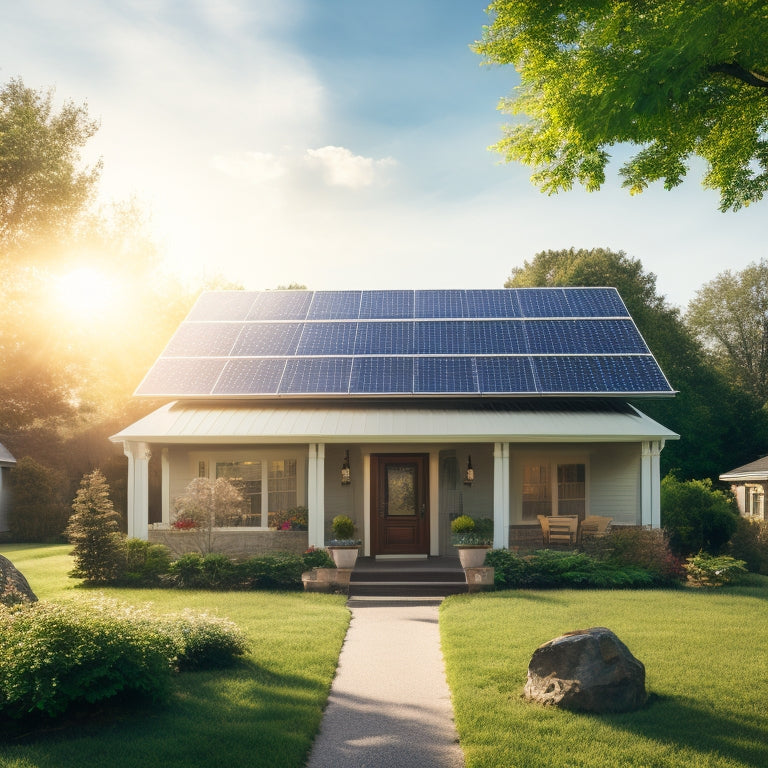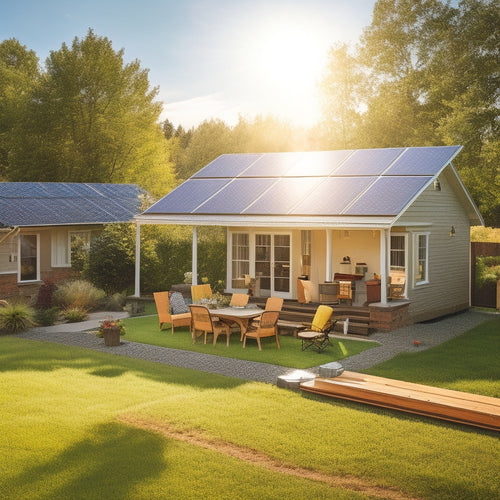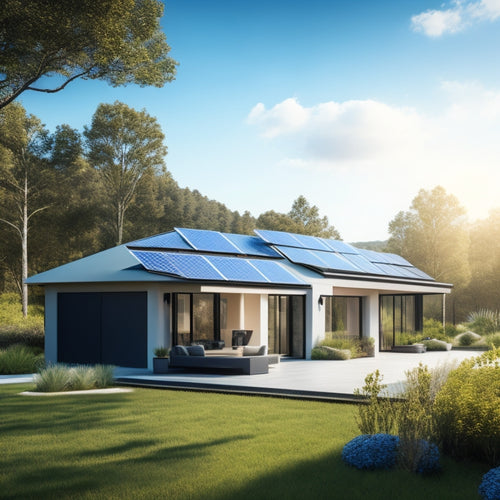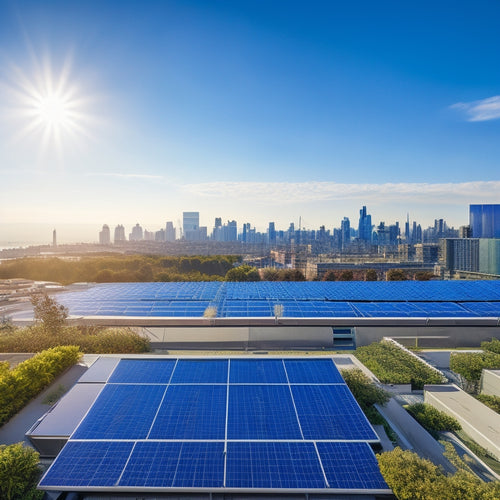
Solar Power Options for Residential Energy Savings
Share
You're looking to utilize solar power to slash your residential energy bills and carbon footprint. You've got multiple options to evaluate. Grid-tied systems connect to the electrical grid, while off-grid systems store excess energy in batteries for autonomy. Hybrid systems combine both features. When it comes to installation, you can opt for roof-mounted or ground-mounted solar panels, each with their own benefits and considerations. Additionally, innovative solutions like solar shingles and community solar programs can enhance your energy independence. As you investigate these options, you'll want to understand the financial incentives, determine your energy needs, and weigh the benefits of each approach to find the perfect fit for your home.
Key Takeaways
- Grid-tied solar systems connect to the electrical grid, allowing homeowners to sell excess energy back and reduce utility bills.
- Off-grid systems operate independently, storing excess energy in battery banks for energy autonomy and zero energy bills.
- Hybrid systems combine grid-tied and off-grid features, providing backup power during grid outages and enhancing energy independence.
- Solar shingles and tiles integrate energy harvesting technology into roofing material, generating clean power while serving as functional roofing solutions.
- Financial incentives, such as the Solar Investment Tax Credit, and state rebates can significantly reduce the cost of solar power installation.
Understanding Solar Power Basics
With solar power becoming an increasingly viable option for homeowners, understanding the basics of this renewable energy source is vital for making informed decisions about residential energy savings.
You'll want to familiarize yourself with fundamental solar energy terminology, such as photovoltaic (PV) cells, which convert sunlight into electricity. It's also important to debunk common solar power myths, like the notion that solar panels only work in direct sunlight. In reality, they can generate power on cloudy days, albeit at a lower capacity.
You should also understand how solar power systems function. When sunlight hits a solar panel, it excites electrons, which flow through an inverter, converting DC power into usable AC electricity for your home.
Net metering allows you to sell excess energy back to the grid and offset your consumption during periods of low sunlight. By grasping these basics, you'll be better equipped to evaluate the feasibility of solar power for your home and make informed decisions about your energy future.
Types of Solar Panel Systems
You have three primary options for solar panel systems: grid-tied systems, which connect to the grid and allow you to sell excess energy back to your utility company; off-grid systems, which operate independently of the grid and typically include energy storage; and hybrid systems, which combine grid-tied and off-grid functionality.
Each type has its own advantages and disadvantages, and the right choice for you'll depend on your specific energy needs and goals.
Grid-Tied Systems
Grid-tied systems, the most common type of solar panel system, connect your solar array directly to the electrical grid. This connection allows you to generate electricity and feed any excess back into the grid, offsetting your energy consumption and reducing your utility bills.
You'll still have access to the grid when the sun isn't shining, guaranteeing a reliable supply of power.
One of the primary benefits of grid-tied systems is net metering. This means you can sell any excess energy you produce back to the utility company and receive a credit on your bill. This credit can be used to offset your energy consumption during periods of low solar production.
Grid-tied systems also provide grid reliability, as you can draw power from the grid when your solar array isn't producing enough electricity. This assures you always have a steady supply of power, even on cloudy days or during the night.
Off-Grid Systems
Operating independently of the electrical grid, off-grid systems store excess energy generated by your solar array in a battery bank for later use, providing complete autonomy from the utility company.
With an off-grid system, you'll enjoy solar independence, relying solely on your solar array for power. This setup is ideal for remote locations or areas with frequent power outages.
Here are some key benefits of off-grid systems:
- Energy autonomy: You're not reliant on the grid, so you won't experience power outages or rate hikes.
- Zero energy bills: Your solar array generates all the power you need, reducing your energy costs to zero.
- Increased property value: Off-grid systems can increase your property value, making it more attractive to potential buyers.
- Environmental benefits: By utilizing renewable energy, you'll reduce your carbon footprint and contribute to a cleaner environment.
Off-grid systems require careful planning and design to guarantee your energy needs are met.
A professional installer can help you determine the right system size and configuration for your specific situation.
Hybrid Systems
Hybrid systems combine the benefits of both grid-tied and off-grid systems, offering a flexible solution for homeowners who want to maximize their solar energy savings. You get the reliability of grid-tied systems and the energy independence of off-grid systems.
Hybrid systems use advanced hybrid technology to optimize system efficiency, allowing you to store excess energy generated during the day for use during the night or on cloudy days.
In terms of cost comparison, hybrid systems are generally more expensive than grid-tied systems but less expensive than off-grid systems. However, they offer a higher level of energy independence and can provide backup power during grid outages.
Maintenance requirements are similar to those of grid-tied systems, with regular checks and replacements of batteries and inverters. Installation challenges include ensuring proper synchronization with the grid and configuring the system to optimize energy storage and usage.
Hybrid systems have a minimal environmental impact and may be eligible for financial incentives, making them an attractive option for homeowners who want to reduce their carbon footprint and energy bills.
Roof-Mounted Solar Installation
Efficiency takes center stage with roof-mounted solar installations, where precision planning and execution converge to employ the sun's energy.
As you consider a roof-mounted solar installation, you'll want to confirm that your solar panels are ideally positioned to capture the sun's rays. Proper solar panel orientation is essential, as it directly impacts the system's overall energy output.
To maximize your energy savings, keep the following considerations in mind:
-
Solar panel orientation: Make sure your panels face the correct direction (south-facing in the northern hemisphere) and are tilted at an ideal angle to capture the sun's energy.
-
Installation maintenance: Regularly inspect and clean your solar panels to maintain their efficiency, and perform routine maintenance on the system's electrical components.
-
Roof compatibility: Verify your roof is structurally sound and can support the weight of the solar panels, and that the installation won't compromise your roof's integrity.
- Local building codes: Familiarize yourself with local building codes and regulations governing roof-mounted solar installations to avoid any potential issues or fines.
Ground-Mounted Solar Options
When it comes to utilizing the sun's energy, you're not limited to roof-mounted solar installations. Ground-mounted solar options offer a viable alternative, allowing you to capture the power of the sun without compromising your roof's integrity. These systems typically consist of solar panels mounted on a racking system, securely anchored to the ground.
One significant advantage of ground-mounted solar options is the flexibility they provide regarding system design and placement. You can choose the best location on your property, considering factors such as shading, wind direction, and soil stability. This allows you to maximize energy production while minimizing visual impact.
However, installation costs for ground-mounted systems are generally higher than those for roof-mounted installations. This is due to the need for additional hardware, such as racking and anchoring systems, as well as the added complexity of the installation process.
Nonetheless, ground-mounted solar options can provide a reliable and efficient source of renewable energy, making them a worthwhile investment for homeowners seeking to reduce their reliance on traditional power sources.
Solar Shingles and Tiles
You're considering solar shingles and tiles as an alternative to traditional solar panels, and for good reason.
These innovative products integrate energy harvesting technology into your roof, generating clean power while serving as a functional roofing material.
With their sleek aesthetic design and seamless installation process, solar shingles and tiles offer a convenient, high-performance solution for homeowners seeking to reduce their energy bills.
Energy Harvesting Technology
One of the most innovative developments in solar power technology is the integration of energy collection capabilities into building materials, specifically solar shingles and tiles.
As you consider solar power options for your home, you can't ignore the advancements in energy collection technology. This integration enables you to generate electricity while maintaining the integrity of your roof.
With solar shingles and tiles, you can increase energy efficiency, reduce your reliance on the grid, and adopt sustainable practices.
Here are some key benefits of energy collection technology in solar shingles and tiles:
-
Renewable energy source: Solar shingles and tiles capture energy from the sun, providing a renewable source of power for your home.
-
Smart energy management: These innovative materials allow for real-time energy monitoring, enabling you to optimize your energy usage and reduce waste.
-
Grid independence: By generating your own electricity, you can reduce your reliance on the grid and enjoy financial benefits through lower energy bills.
- Environmental impact: Solar shingles and tiles minimize your carbon footprint, contributing to a cleaner environment and reducing your environmental impact.
While installation challenges may arise, the benefits of energy collection technology in solar shingles and tiles make them an attractive option for homeowners seeking to increase energy efficiency and reduce their reliance on non-renewable sources.
Aesthetic Design Benefits
The sleek, modern design of solar shingles and tiles seamlessly integrates into your home's structure, enhancing its curb appeal while generating clean energy.
You'll appreciate the aesthetic appeal of these innovative products, which blend in with your roof's existing design. The design integration is so seamless that it's hard to tell where the solar panels begin and the traditional roofing ends.
This visual harmony creates a stunning structural enhancement, raising your home's value and residential charm. Plus, you can choose from a range of colors to customize the look and guarantee landscaping collaboration.
Whether you have a modern, contemporary, or traditional-style home, solar shingles and tiles can be customized to match your exterior design. The result is a stylish installation that not only saves you money on energy bills but also enhances your home's overall aesthetic.
Seamless Installation Process
During the installation process, your roof undergoes a change as solar shingles and tiles are carefully integrated into its structure. This seamless process guarantees a hassle-free shift to renewable energy.
To secure a smooth installation, it's crucial to work with a reputable contractor who's extensive experience with solar shingle and tile installations.
When selecting a contractor, consider the following key factors:
-
Installation timeline: Confirm the contractor provides a realistic project timeline, including milestones and deadlines.
-
Contractor selection: Research and verify the contractor's certifications, licenses, and insurance coverage.
-
Roof assessment: The contractor should conduct a thorough roof assessment to identify any potential issues or necessary repairs.
- Warranty and support: Review the warranty and support options offered by the contractor and manufacturer.
Community Solar Programs
As you investigate ways to employ solar power for your residential energy needs, community solar programs emerge as a viable option, particularly if your property isn't suitable for rooftop solar panels. These programs allow multiple individuals or organizations to share the benefits of a single solar array, promoting community participation and energy equity. Through solar cooperatives, local energy is generated and distributed, reducing the environmental impact of traditional power sources.
Here is a breakdown of community solar program benefits:
| Benefit | Description |
|---|---|
| Shared Savings | Participants share the cost and benefits of a single solar array |
| Community Outreach | Programs often involve local community outreach and education |
| Subscription Models | Flexible subscription options allow for varying levels of participation |
| Environmental Impact | Collectively reduces carbon footprint and supports renewable energy |
| Energy Equity | Increases access to solar power for those who can't install rooftop panels |
Solar Energy Storage Solutions
With solar power becoming an increasingly prominent part of your residential energy mix, you'll want to contemplate pairing it with solar energy storage solutions to optimize your energy savings.
This integration enables you to store excess energy generated during the day for use during periods of low sunlight or at night, reducing your reliance on the grid and further decreasing your energy bills.
When selecting a solar energy storage solution, consider the following key aspects:
-
Battery Technologies: Look for advanced battery technologies like lithium-ion, lead-acid, or flow batteries that offer high efficiency, long lifespan, and low maintenance.
-
Energy Management: Ascertain the solution comes with a sophisticated energy management system that can monitor your energy usage, optimize energy storage, and provide real-time feedback.
-
Scalability: Choose a solution that can be scaled up or down to accommodate your changing energy needs.
- Compatibility: Verify that the storage solution is compatible with your existing solar panel system and inverter.
Incentives and Rebate Programs
You've invested in a solar power system and paired it with a suitable energy storage solution, now it's time to examine the financial benefits that come with it.
As a residential solar power user, you're entitled to various incentives and rebate programs that can considerably reduce your upfront costs.
Federal incentives, such as the Solar Investment Tax Credit (ITC), allow you to claim a tax credit of up to 26% of your total solar power system cost. Additionally, state rebates and local grants can provide further financial assistance.
For instance, some states offer rebates of up to $1 per watt of installed solar power capacity.
Financing options, such as solar loans, can also help you cover the initial investment. Many utility programs offer special tariffs and rates for solar power users, which can lead to considerable energy efficiency savings over time.
Determining Your Solar Needs
Your energy consumption patterns play an essential role in determining the ideal solar power system for your residential needs. To get an accurate assessment, you'll need to understand your energy usage habits. This involves analyzing your past electricity bills to identify your average daily energy consumption in kilowatt-hours (kWh).
Conducting a solar assessment will aid you in determining the size of the solar power system you need. Here's what you should consider:
-
Peak sun hours: The amount of sunlight your location receives daily affects the system's performance.
-
Roof size and orientation: Confirm your roof is large enough and faces the right direction to accommodate the solar panels.
-
Energy efficiency: Identify opportunities to reduce your energy consumption through efficient appliances and lighting.
- Backup power needs: Decide if you want a battery backup system to provide power during outages or nighttime.
Frequently Asked Questions
Can I Install Solar Panels on a Rented Property?
You typically need your landlord's permission to install solar panels on a rented property, but you can investigate a solar lease, which may not require installation; check your tenant rights to guarantee you're protected in the agreement.
How Often Should I Clean My Solar Panels?
You should clean your solar panels every 6-12 months, depending on your location and climate, as part of regular solar panel maintenance to guarantee peak energy production, as dirty panels can reduce efficiency by up to 25%.
Will Solar Panels Increase My Property Value?
You'll likely see a significant increase in property value with a solar investment, as it enhances energy efficiency and appeals to environmentally conscious buyers, increasing your home's attractiveness and resale value.
Can I Use Solar Power During a Grid Outage?
Did you know 77% of US homeowners prioritize energy independence? You can achieve this with solar power during a grid outage by investing in solar battery storage, which stores excess energy generated by your grid tie systems for later use.
Are Solar Panels Resistant to Extreme Weather?
You're right to wonder about solar panel durability; fortunately, most modern panels are designed to withstand extreme weather performance, including high winds, hail, and heavy snow loads, ensuring your power supply remains stable even in harsh conditions.
Conclusion
You've made it to the end of this solar power expedition, and yet, you're still stuck in the dark ages of energy consumption. Just kidding! With the vast array of solar power options outlined above, you're now well-equipped to capture the sun's energy and slash your electricity bills. So, what's holding you back? Join the solar revolution and start soaking up those rays – your wallet (and the planet) will thank you.
Related Posts
-

Steps to Prepare for Solar Installation
To prepare for solar installation, start by evaluating your current energy consumption and future needs to determine ...
-

Eco-Friendly Energy Storage Systems for Houses
Eco-friendly energy storage systems for your house let you capture and use renewable energy efficiently. You can choo...
-

Business Solar Investments for Cost-Effective Sustainability
Investing in solar energy is a smart move for your business, providing a solid foundation for cost-effective sustaina...


